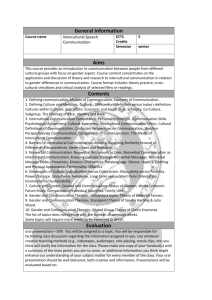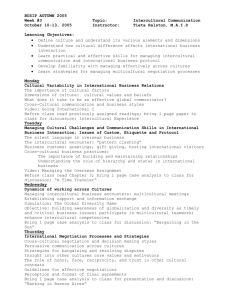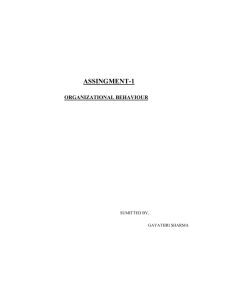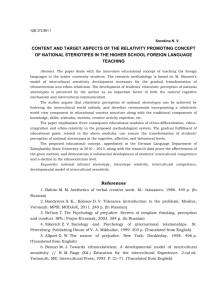Full Article
advertisement
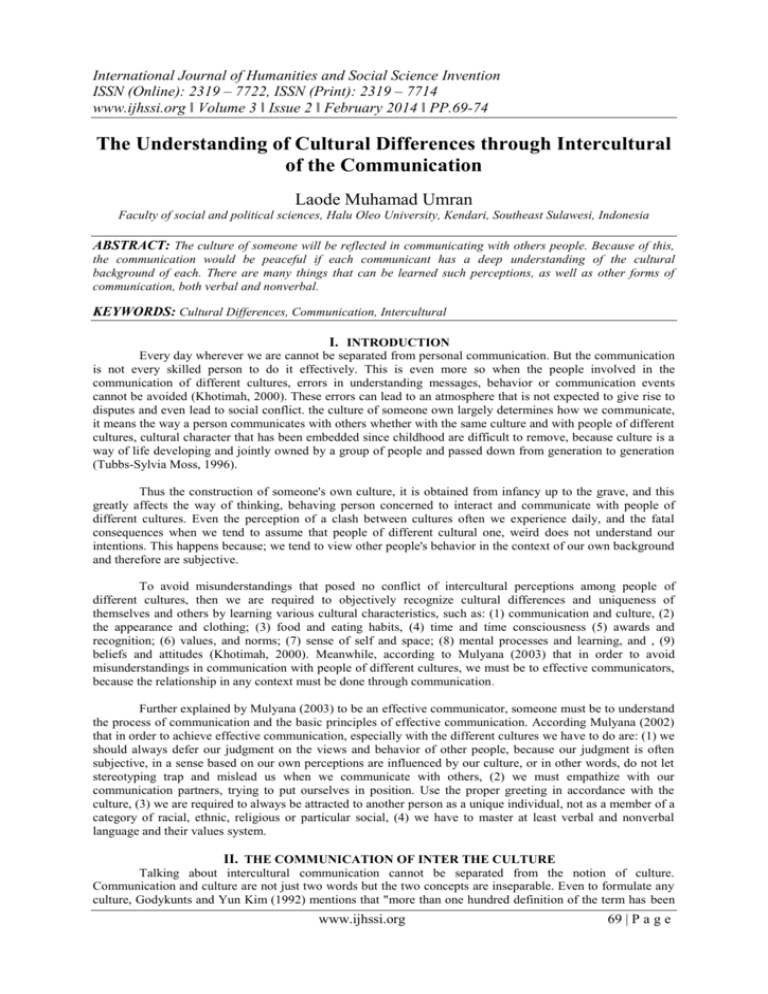
International Journal of Humanities and Social Science Invention ISSN (Online): 2319 – 7722, ISSN (Print): 2319 – 7714 www.ijhssi.org ǁ Volume 3 ǁ Issue 2 ǁ February 2014 ǁ PP.69-74 The Understanding of Cultural Differences through Intercultural of the Communication Laode Muhamad Umran Faculty of social and political sciences, Halu Oleo University, Kendari, Southeast Sulawesi, Indonesia ABSTRACT: The culture of someone will be reflected in communicating with others people. Because of this, the communication would be peaceful if each communicant has a deep understanding of the cultural background of each. There are many things that can be learned such perceptions, as well as other forms of communication, both verbal and nonverbal. KEYWORDS: Cultural Differences, Communication, Intercultural I. INTRODUCTION Every day wherever we are cannot be separated from personal communication. But the communication is not every skilled person to do it effectively. This is even more so when the people involved in the communication of different cultures, errors in understanding messages, behavior or communication events cannot be avoided (Khotimah, 2000). These errors can lead to an atmosphere that is not expected to give rise to disputes and even lead to social conflict. the culture of someone own largely determines how we communicate, it means the way a person communicates with others whether with the same culture and with people of different cultures, cultural character that has been embedded since childhood are difficult to remove, because culture is a way of life developing and jointly owned by a group of people and passed down from generation to generation (Tubbs-Sylvia Moss, 1996). Thus the construction of someone's own culture, it is obtained from infancy up to the grave, and this greatly affects the way of thinking, behaving person concerned to interact and communicate with people of different cultures. Even the perception of a clash between cultures often we experience daily, and the fatal consequences when we tend to assume that people of different cultural one, weird does not understand our intentions. This happens because; we tend to view other people's behavior in the context of our own background and therefore are subjective. To avoid misunderstandings that posed no conflict of intercultural perceptions among people of different cultures, then we are required to objectively recognize cultural differences and uniqueness of themselves and others by learning various cultural characteristics, such as: (1) communication and culture, (2) the appearance and clothing; (3) food and eating habits, (4) time and time consciousness (5) awards and recognition; (6) values, and norms; (7) sense of self and space; (8) mental processes and learning, and , (9) beliefs and attitudes (Khotimah, 2000). Meanwhile, according to Mulyana (2003) that in order to avoid misunderstandings in communication with people of different cultures, we must be to effective communicators, because the relationship in any context must be done through communication. Further explained by Mulyana (2003) to be an effective communicator, someone must be to understand the process of communication and the basic principles of effective communication. According Mulyana (2002) that in order to achieve effective communication, especially with the different cultures we have to do are: (1) we should always defer our judgment on the views and behavior of other people, because our judgment is often subjective, in a sense based on our own perceptions are influenced by our culture, or in other words, do not let stereotyping trap and mislead us when we communicate with others, (2) we must empathize with our communication partners, trying to put ourselves in position. Use the proper greeting in accordance with the culture, (3) we are required to always be attracted to another person as a unique individual, not as a member of a category of racial, ethnic, religious or particular social, (4) we have to master at least verbal and nonverbal language and their values system. II. THE COMMUNICATION OF INTER THE CULTURE Talking about intercultural communication cannot be separated from the notion of culture. Communication and culture are not just two words but the two concepts are inseparable. Even to formulate any culture, Godykunts and Yun Kim (1992) mentions that "more than one hundred definition of the term has been www.ijhssi.org 69 | P a g e The Understanding of Cultural Differences through… suggested". While the communication itself is so diverse and controversy in the definition, or in other words, the communication among experts there is no uniformity. But clearly by William B. Hart II quoted from Liliweri (2003) states that the study of intercultural communication can be defined as a study that emphasizes the effects of culture on communication. Even Edward T Hall quoted from Khotimah (2000) explicitly states that "culture is communication and is culture". The communication and Intercultural is communication between people of different cultures (both in terms of race, ethnicity, or socioeconomic differences) by Mulyana (2001). Meanwhile, according Liliweri (2003) is the process of intercultural communication message a person through certain channels to others who both come from different cultural backgrounds and produce a certain effect. Meanwhile, according to Dodd (1991) that intercultural communication includes communication involving participants representing private communication, interpersonal, and group, with an emphasis on differences in cultural backgrounds influence the communication behavior of the participants. Based on the opinions expressed by the Mulyana and Liliweri give an understanding that the intercultural communication occurs between people of different culture, race, language, religion, level of education, social status, or even gender, as well as closely related to human communication (human communication), as revealed by Somavar and Porter (1991), which states that "intercultural interaction to understands one must first understand human communication" In terms of intercultural communication Fisher quoted from Mulyana and Rakhmad (2001) also suggests that in addition to looking at the position of the communicator and the communicant to another factor, namely the message. Messages addressed in intercultural communication behavior are not just a message for the influence of personal folkways but the influence of society. The message was the same as the symbol of the culture that surrounds a particular personal when she intercultural communication. With such attitudes, behaviors, actions of someone in intercultural communication are not an attitude, behavior, personal actions but rather a symbol of the society. Messages in intercultural communication are symbols that it contains characteristics of the communicator is heard or seen in the experience of interpersonal communication processes between different ethnic them. In communication intercultural according Liliweri (2003) the greater the degree of difference between cultures, the greater the loss of opportunity to formulate a degree of certainty an effective communication, so there must be a guarantee of the accuracy of the interpretation of verbal messages and nonverbal. This is caused when we are communicating with someone from a different culture, then we have also a number of differences in terms of, for example degree of knowledge, the degree of difficulty in forecasting, the degree of ambiguity, confusion, mysterious atmosphere that cannot be explained, not useful even hostile. That's why according to Schraman quoted from Mulyana and Mercy (2001), to achieve intercultural communication truly effective there are some things that need our attention, are: (1) respect members of other cultures as a human, (2) respect other cultures as it is and not as desired, (3) respect the right of members of other cultures to act differently from how to act, and (4) cross-culturally competent communicators must learn to love to live with people from other cultures. Furthermore DeVito (1997), uses the term intercultural communication broadly to include all forms of communication between people from different groups in addition also includes a narrow field of communication between different cultures, as follows: (1) Communication between cultures for example: between the Chinese and Portuguese, or between France and Norway, (2) communication between the races are different (sometimes mere interracial communication), for example: among white men with blacks; (3) Communication between different ethnic groups is (sometimes called inter-ethnic communication) for example: among Americans of Italian descent to the American people of German descent; (4) Communication between different religious groups, for example: between Roman Catholics with Episcope, or between Muslims and Jews; (5) Communication between different nations (sometimes called international communications) for example, between the United States and Mexico, or between France and Italy; (6) Communication between different subcultures and the dominant culture, for example: between the homesick and heterosexual women, or between the elderly and young people; (7) Communication between the sexes between men and women. Of various descriptions, it can provide the understanding that the people who influenced different cultures and subcultures will communicate differently. Different cultures and subcultures become a source for enriching the communication experience and not as a barrier to interaction. For that we need to understand and appreciate the differences. There are three important things to note in communication intercultural understanding, namely perception, verbal www.ijhssi.org 70 | P a g e The Understanding of Cultural Differences through… communication, and nonverbal communication. The third element is the basic building caused the failure, as well as the success of intercultural communication. 2.1 Perception Perception is the process of uncovering the meaning of social objects and events that we experience in our environment. Each person will have a different picture of the reality around him. Social perception is not as simple as the perception of the physical environment. Social perception, which appears in a communication containing some important principles (Mulyana, 2003), namely: (a) perception based on experience, (b) perception is selective; (c) perception is alleged; (d) perceptions are evaluative, and (e) the perception is contextual. 1. Perception based on experience Human perception of a person, object, or event and their reactions to these things based on experience / learning their past relating to people, objects or similar incident. How to assess a person's ideal woman, the ideal husband, work, school, appropriate behavior, dress code and other common really depends on what has been taught by the culture in which the person resides. The next illustration to explained about principle that. Westerners are accustomed to eating with a spoon, fork and knife will assume the East who eat with their hands as obscenity, though the utensils they use have often used other people, moreover those who ate the East always use his own hands as never used by others. In the West generally, also most of Indonesia, burping while or after eating behavior that is disrespectful, even in Sweden a guest who burp after eating can make the hostess passed out, while in Arabic, Chinese, Japanese, and Fiji, also in Aceh and West Sumatra, burp even the recommended because it instills acceptance and satisfaction of eating food. Similarly, in speaking with high intonation, for the Javanese considered less so polite, but some cultures such as those of Sulawesi, Sumatra, Borneo is reasonableness. 2. Characteristically Selective Perception Every time a person will in forgoing by sensory stimuli millionaire. Fortunately no attention to the man, so that people will only stimuli that capture attention only. There are two factors that affect this attention, namely: (1) internal factors, and (2) external factors. Internal factors is influenced by biological factors (hunger, thirst, and so on); physiological factors (tall, short, fat, skinny, healthy, sick, tired, less than perfect vision or hearing, disability, etc.), and social factors culture such as gender, religion, level of education, occupation, income, role, social status, past experiences, habits and even psychological factors such as willingness, desire, motivation, hope, and so on. The greater the difference in these aspects are inter-individual, the greater the difference in their perception of reality. External factors that affect the perception of the people in making an object, the object attributes are perceived as motion, intensity, contrast, novelty, and looping object perceived. Moving objects more interesting than the stationary object. For example, we are more like television as a moving picture of the comic as a still image. Similarly, a prominent stimulus intensity will also attract attention, someone who the loudest, the most obese body, the skin is black, or the face of the most beautiful will attract our attention. In the meantime, the person or object that looks different from the others (contrast) will also attract attention, like an albino, black people amongst those who were white, a veiled woman, bikini-clad woman among women other women who dress more decently on the beach, next to his ear youth relay among his friends who did not look so. Likewise, it is an element of novelty objects that give rise to concern; it is clear when we look at new students more interesting than the old students who are already known. We also tend to pay attention to something new, for example who wore new clothes, a new car was carrying. An event that is always repeated more clearly the potential to be considered, making it possible to easily remember the object of concern. Like the ads a product that aired repeatedly on television, will be pushed to buy the goods being advertised. 3. Characteristically perception Alleged The information to obtain through the sensing object is never complete, often lead to the perception of a direct jump to conclusions. This process causes people to interpret a more complete object. For example, we saw an airplane in the sky; we do not see the flight crew and passengers. But we have repeatedly seen an airplane in the sky which indicates that there are at least a flight crew flies the plane. Similarly, when we see if there is a ship in the distance, we immediately imagine there are a number of people in it, there are a number of car and ship equipment such as stoic and so on. www.ijhssi.org 71 | P a g e The Understanding of Cultural Differences through… 4. Characteristically Evaluative Perception Most people go through their days with a sense that their perception of what is real. They assumed that receives the message and interprets it as a natural process. So the assumption that a certain degree true, but sometimes these tools and our perception senses deceive us so that we also feel how close to reality the actual perception. Or in other words that in perceiving an object will never happen objectively, this is because in perceiving greatly influenced past experience and personal interests. The Perception of personal and subjective. By Andrea I. Rich in Mulyana, (2003) essentially represent the perceptions of physical and psychological individual instead of showing the characteristics and the absolute quality of the perceived object. For example, when we are silent, we tend to judge people jolly as outgoing and sociable, and vice versa. 5. Characteristically Contextual Perception External stimuli must be in organizing. Of all the influences that exist in our perception, the context is one of the most powerful influences. Context that surrounds us when within sight of an event or object greatly affects cognitive structure, expectations and therefore also our perception. This contextual perception using the following principles: (1) contextual in the sense of object structure, or events based on the principle of similarity or closeness and completeness, (2) contextual in the sense, we tend to perceive a stimulus, or events, for example when we fill the puzzle cross (TTS), this principle clearly applies. According Somavar and Porter (1991); Mulyana (2003) that there are six elements of culture that directly affect our perceptions when communicating with people from other cultures, namely: (a) beliefs, values, and attitudes; (b) worldview, (c) social organization, (d) human nature, (e) activity orientation, (f) perception of self and others. Trust is a subjective notion that an object or event has certain traits or values, with or without evidence. Nature of trust is not limited, for example, the Lord is One, Adam was the first man on earth, AID is a dangerous disease or English language skills are important for career. Value is the evaluative component of the trust that includes usability, goodness, aesthetic, and satisfaction. So the normative value, notify a member of a culture about what is good and bad, right and wrong, who should be defended, what must be fought for, what should we fear, and so on. Value is usually sourced from the larger philosophical issues that are part of the cultural environment; therefore the value is stable and difficult to change. For example, based on their view of the individualist, the West over glorifying the privacy of the Eastern people. The world view is a cultural orientation towards God, life, death, the universe, the truth, the material (wealth), and other philosophical issues related to life (Somavar and Porter, 1991). Include religious world view and ideology. Various world religions have a concept of God and the prophet hood different. Different ideologies also have a different concept of how the relationship between one human being by another human being. So the view of the world is an important element that affects a person's perception when communicating with others, especially different cultures (Mulyana, 2003). The organization of social whether formal or informal nature, also affects us in perceiving the world and this life which in turn affects our behavior. According Mulyana (2003) informal institutions that influence perceptions and behaviors we are a family, while the formal institutions are the government. The device even though no written rules in the set are affecting us in communicating. Similarly, the rules issued by the government either in writing or do not also have the same effect in the perception and behavior. Government through the rules, norms decides until certain degree communication communications of its citizens either directly or mediated communication, including mass communication. Each state usually has a specific communication system, in Western countries generally adheres communication systems that people communicate more freely. Authoritarian states are still government controlled mass media; people are not free to broadcast information to the general public, even writing the story must be approved by a legitimate government. In addition to these two institutions by Mulyana (2003), which may also affect our perceptions are educational institutions (schools, universities), religious communities (in Islam are Sunni, Shia, Nahdlatul Ulama, Muhammadiyah, Persis and the Christians are Catholic, Protestant , Adventist, Pentecostal, Witness Yohava), community antic (Javanese, Minangkabau Batak, Sundanese, Malay), social class and political party. Our view of who we are, how the nature or character also affects the way we perceive our social and physical environment. Muslims, for example, the view that human beings are the most precious compared to other creatures such as angels, jinn, animals and plants, since human beings are endowed by reason. But that glory by Mulyana (2003) can only be obtained when human faith and do good works (using his wits with the www.ijhssi.org 72 | P a g e The Understanding of Cultural Differences through… correct way), otherwise when the activities are always under lust, then they are most inferior beings. Similarly, in looking at the man, the Muslims believe that humans are born in a state of purity clean, while the Christians believe that human beings inherit the sin of Adam and Eve. Some groups have an opinion different again depending on the human, for example there are groups who argue that people are basically good or basically evil. And there is also the having different theories about what makes humans have a certain character. Human vision regarding this will affect the perception, of the view that the primitive-irrational, scientific to the religious. Human orientation on how the human relationship with nature also affects the perception of the natural treat. Those who view humans as natural rulers and conquerors of nature will exploit nature for the wellbeing, while those who believe that human beings are part of nature or one with nature, will strive to act in harmony with nature, utilizing nature, but seeks to maintain it from being damaged or destroyed. Another aspect that also influences our perception is our view of the activity, for example, in certain cultures view of which a person is (king, son presidents, officials, degree) is more important than what it does. Instead there is a culture that sees his achievements more important than who he is, for example, in the West. Eastern societies, in general, are a collective society. In the culture of collectivity, self is not unique or autonomous, but melting in the group (family, clan, group work, ethnicity and so on). Whereas in individualist cultures (the West) are autonomous. But a culture can actually just have a tendency of individualist and collectivist, such as orientation activities are usually more prominent one (Mulyana, 2003). Further said by Mulyana (2003) that in collectivist societies, individuals are bound by fewer groups, but stronger attachment to the group and longer. In addition to the relationship between individuals in a group is the total, while in the domestic sphere and in public spaces. Consequently individual behavior is strongly influenced group. Individuals are not encouraged to stand alone. Individual success is the success of the group. In contrast to human’s individualist, individualists are less tied to the group, including the extent of the family. More individualist humans engage in a horizontal relationship of the vertical relationship. They are more proud of the achievements of the paper, such as gender, age, family names, and so on (Landis & Brislin, 1988). Relationships amongst themselves seem shallower than the relationship between the collectivity, too calculative. The relationship will last a long time as far as they benefit materially (Mulyana, 2003). 2.2 The Verbal of Communication Mulyana (2003) says that language as verbal coding system is formed of a set of symbols, with the rules for combining these symbols, which are used and understood a community. Andrea L. Rich quoted from Mulyana (2003) says that the language itself bound by culture. Therefore, according to the Sapir-Whorf hypothesis, often called Linguistic Relativity Theory, in fact every language shows a typical symbolic world, which depicts the reality of the mind, spiritual experiences, and needs of the wearer. So different languages actually influence the wearer to think, look at the environment, and the universe around it in different ways, and therefore behave differently. In line with the opinions expressed by Andrea L Rich, according Ohoiwutun (1997) in intercultural communication that must be considered, namely: (1) when people talk, (2) what was said, (3) notice it, (4 ) intonation, (5) stiff and poetic style, and (6) indirect language. Many happen day-to-day because of lack of attention to these differences, for example due to pronounce certain words, which is interpreted differently by people of different cultures, causing misunderstanding, hatred, and human relations cracks 2.3 Nonverbal of Communication Simply put, the message is all the nonverbal cues that are not words (Mulyana, 2003). As the words mostly nonverbal cues are also not universal, but are bound by culture, so it is learned, not innate. Few nonverbal cues are innate. We are all born and knows how to smile, but where, when, and to whom we show the emotions studied, and thus affected context and cultural. Nonverbal symbols are very difficult to interpret when compared with verbal symbols. Nevertheless, we often see that the nonverbal language tends aligned with verbal language, for example, every movement in sync with speech, like we agreed is always accompanied by a nod of the head. According Liliweri (2003) when it comes to using nonverbal messages there are several factors that affect intercultural communication, namely: 1) Kinesthetic is related to body language, which consists of body position, body orientation, facial appearance, body image. There seems to be a difference between the meaning and significance of the movements of the body or limbs displayed. www.ijhssi.org 73 | P a g e The Understanding of Cultural Differences through… 2) 3) 4) 5) 6) 7) 8) 9) Okulesik is eye movement and eye position. There is a difference in meaning between the eyebrows appear human. Each variation of eye movements or eye position represents a specific meaning, such as love, anger and so on. Hap tic, is about tactile or permit how far a person holding and embracing others. Proksemik is about the relationship between space, between distance and time to communicate, for example, the closer the more familiar meaning, the further it means less and less familiar. Kronemik is about the concept of time, the same as other non-verbal message that the concept of time considered that an obedience culture at the time was a high culture or civilization forward. The size of time or at a later time obedience that produce notions of people with lazy, lazy responsible, people who have never adhere to time. Display, Appearance namely how a show has enough self or shows a very high correlation with the evaluation of the person. This includes biological view and the view is sought or in shape. Display example of biological skin color, and eye color, hair texture and color, as well as body structure. There is a stereotype that is excessive in view of the behavior of a biological. Model outfit also affect our evaluation of others. Posture, is body display time of the standing and sitting. The way how people sit down and stand can be interpreted in the context of intercultural together. For example, if people do not feel free Java if standing upright in front of older people has to stoop so respectful, otherwise sitting cross-legged in front of an older person is respectful manner. Paralinguistic messages interpersonal communication is a message that is a combination of verbal and non-verbal behavior. Paralinguistic consists of one unit of sound, or movement that displays a specific purpose with a specific meaning. Paralinguistic also plays a major role in intercultural communication Symbolism and passive non-verbal communication, some of which are the symbolism of colors and numbers. III CONCLUSIONS Every people of us is unique, meaning that even if raised in the same cultural environment, not necessarily every person in the group will be exactly the same in thinking and behaving, because there will be a sub-sub-culture that is more specific influence on behavior in communication. Culture and communications that have a reciprocal relationship, like two sides of one coin. Culture becomes part of the communication behavior, and in turn also helped determine communication, maintain, develop or pass on culture. What are we talking about, how we talk, what we see, notice, or ignore, how we think, and what we think is influenced by culture. In turn, what we talk about, how we talk, what we saw helped shape, define, and revive our culture. So Edward T. Hall in Mulyana (2003) states that culture is communication and communication is culture. Even Porter and Samovar states that culture is not a life without communication and the communication was not live without culture. REFERENCES [1] [2] [3] [4] [5] [6] [7] [8] [9] [10] [11] [12] [13] [14] [15] [16] [17] De Vito, Josep A. 1997. Komunikasi Antar Manusia, Terjemahan Agus Maulana, Jakarta: Profesional Books. Dodd, Charley, H. 1991. Dynamics of intercultural Communication, Wm. C.Brown Publishers, Dubuque, IA/USA. Effendi, Onong Uchjana, 1993. Dinamika Komunikasi, Bandung: Remaja Rosdakarya. Effendi, Onong Uchjana, 1995. Ilmu Komunikasi, Teori dan Praktek, Bandung: Remaja Rosdakarya. Gudykunst, W.B, & Yun Yun, Kim 1992. Communicating with strangers: An approach to intercultural communication (Ed), New York: McGraw Hill, Inc Khotimah, Emma. 2000. Memahami Komunikasi Antarbudaya, Dalam: Jurnal Editor, Vol, 1 No. 1, Bandung: Unisba. Landis, D. & Brislin, R. (Ed). 1988. Handbook of intercultural training, Vols 1-3, New York: Pergamon Press. Liliweri, Alo. 203. Dasar-Dasar Komunikasi Antarbudaya, Yogyakarta: Pustaka Pelajar. Mulyana Deddy, 1996. Mengapa Kita Mempelajari Komunikasi: Sebuah Pengantar, Dalam: Human Communication: KonteksKonteks Komunikasi, Buku Pertama, Bandung: Remaja Rosdakarya. Mulyana Deddy, 2001. Mengapa dan Untuk Apa Kita Mempelajari Komunikasi Antar Budaya, Dalam: Komunikasi Antar Budaya, Panduan Berkomunikasi Dengan Orang-Orang Berbeda Budaya, Editor: Deddy Mulyana dan Jalaluddin Rakhmat, Bandung: Remaja Rosdakarya. Mulyana Deddy, 2003. Ilmu Komunikasi, Suatu Pengantar, cetakan kelima, Bandung: Remaja Rosdakarya. Mulyana Deddy, 2002. Komunikasi Jenaka, Parade Anekdot, Humor, dan Pengalaman Konyol, Cetakan kedua, Bandung: Remaja Rosdakarya. Mulyana Deddy, 2005. Nuansa-Nuansa Komunikasi, Meneropong Politik dan Budaya Komunikasi Masyarakat Kontemporer, Remaja Rosdakarya, Bandung. Ohoiwutun. 1997. Sosiolinguistik, Memahami Bahasa Dalam Konteks Masyarakat dan Kebudayaan, Jakarta: Visipro. Sihabudin, Ahmad. 2011. Komunikasi Antar Budaya, Satu perspektif Multidimensi, Bumi Aksara, Jakarta Somavar, Larry and Porter, Richard E, 1991. Communication Between Cultures, Belmont: C.A. Wadsworth. Schramm, Wilbur. 2001. Perihal Membangun Jembatan, Dalam: Komunikasi Antar Budaya, Panduan Berkomunikasi Dengan Orang-Orang Berbeda Budaya, Editor: Deddy Mulyana dan Jalalluddin Rakhmat, Bandung: Remaja Rosdakarya. www.ijhssi.org 74 | P a g e

